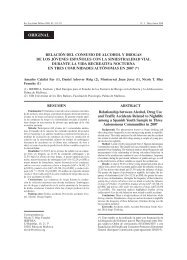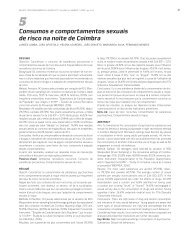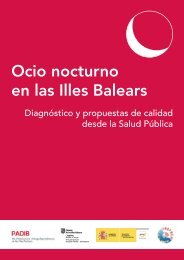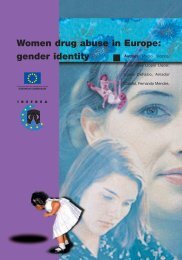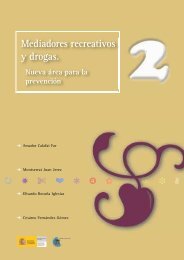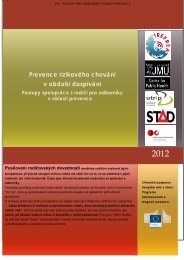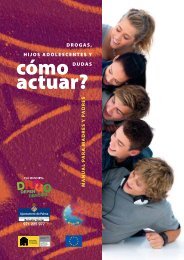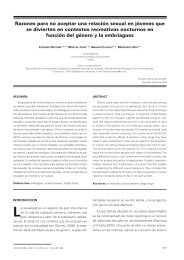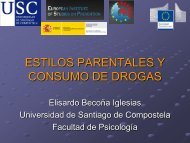Characteristics and social representation of ecstasy in Europe - Irefrea
Characteristics and social representation of ecstasy in Europe - Irefrea
Characteristics and social representation of ecstasy in Europe - Irefrea
You also want an ePaper? Increase the reach of your titles
YUMPU automatically turns print PDFs into web optimized ePapers that Google loves.
had used <strong>ecstasy</strong> or a similar substance once <strong>in</strong> their lifetime was 5,10%, <strong>in</strong> thepreced<strong>in</strong>g twelvemonths 3,9% <strong>and</strong> <strong>in</strong> the preced<strong>in</strong>g month 2,2%. Differentiat<strong>in</strong>gbetween the use <strong>of</strong> MDMA <strong>and</strong> any other synthetic drug is not easy s<strong>in</strong>ce, <strong>in</strong> additionto the typical aspects such as <strong>ecstasy</strong> tablets not always conta<strong>in</strong><strong>in</strong>g the said substance,it also has to be added that the Spanish user very <strong>of</strong>ten identifies synthetic drugs withrather broad descriptions such as pastillas ‘tablets’. In 1994, the life prevalence amongthe same population was 3,5%, the preced<strong>in</strong>g year 3% <strong>and</strong> the preced<strong>in</strong>g month 2%.Other substances such as amphetam<strong>in</strong>es, used by the students dur<strong>in</strong>g the period from1994-1996, rose from 3,3% to 4,15% <strong>and</strong> the halluc<strong>in</strong>ogens from 4 % to 5,3%accord<strong>in</strong>g to the same survey. Dur<strong>in</strong>g that same period, there was a significant <strong>in</strong>crease<strong>in</strong> the use <strong>of</strong> cannabis, halluc<strong>in</strong>ogens, amphetam<strong>in</strong>es, <strong>ecstasy</strong>, coca<strong>in</strong>e <strong>and</strong> tobaccoamong the Spanish school population, the average age <strong>of</strong> first use <strong>of</strong> tobacco, syntheticdrugs <strong>and</strong> tranquillisers dropp<strong>in</strong>g <strong>and</strong> that <strong>of</strong> alcohol use ris<strong>in</strong>g.In a household survey <strong>of</strong> the general population, conducted <strong>in</strong> December 1995 on asample at a national level <strong>of</strong> 9.984 people over 15 years <strong>of</strong> age (PLAN NACIONALSOBRE DROGAS, 1997), life prevalence was 1,6%, preced<strong>in</strong>g year 1,1% <strong>and</strong>preced<strong>in</strong>g month 0,3%. If we study it by age groups, we f<strong>in</strong>d that <strong>in</strong> the 15 to 18 agegroup, the proportion who had used it at some time was 2,4%, between 19 <strong>and</strong> 24 years44,9%, <strong>and</strong> between 25 <strong>and</strong> 39 years 2,3%. The majority <strong>of</strong> the users were males(70,1%), aged between 20 <strong>and</strong> 29 years <strong>of</strong> age (61,7%), s<strong>in</strong>gle (77,4%), <strong>and</strong> lived withtheir family <strong>of</strong> orig<strong>in</strong> (59,6%). The majority had elementary or secondary education <strong>and</strong>belonged to the middle classes. Multi-use among these <strong>ecstasy</strong> users is frequent <strong>and</strong>highly preoccupy<strong>in</strong>g as dur<strong>in</strong>g the preced<strong>in</strong>g year they had taken alcohol (92,2%),cannabis (76%), coca<strong>in</strong>e (47,3%), amphetam<strong>in</strong>es (30,5%), halluc<strong>in</strong>ogens (29,8%),hero<strong>in</strong> (19,9%) <strong>and</strong> tranquillisers or hypnotics (18,6%). Only 29,3% had used <strong>ecstasy</strong>on 10 or more occasions throughout their life. Asked about the largest number <strong>of</strong> tabletstaken <strong>in</strong> one session, 20,3% had taken 3 or more tablets. Among these users adverseeffects were frequently experienced -dry mouth (75,5%), m<strong>and</strong>ibular tension (55,3%)disorientation (45,9%), tachycardia or palpitations (45,5%) anxiety, irritability or panic(37,1%), shiver<strong>in</strong>g (34%), auditory or visual halluc<strong>in</strong>ations (31,6%), digestive problems(31,6%) <strong>and</strong> trembl<strong>in</strong>g (21,8%).FRANCEThe expansion <strong>in</strong> France corresponded to the n<strong>in</strong>eties, above all, the first problemswith the police aris<strong>in</strong>g from the raves <strong>of</strong> 1991. Concern for the phenomenon has led toa harden<strong>in</strong>g <strong>of</strong> repressive measures s<strong>in</strong>ce 1996. Accord<strong>in</strong>g to a report <strong>of</strong> the‘Observatoire Français des Drogues et Toxicomanies’ <strong>in</strong> March 1997, it was calculatedthat 50,000 people occasionally or habitually use <strong>ecstasy</strong> <strong>and</strong> that they are generallymale ,between 18 <strong>and</strong> 25 years <strong>of</strong> age, connected to the techno, raves etc. scenes, witha high level <strong>of</strong> pr<strong>of</strong>essional users.The situation <strong>in</strong> France (see also Chapter 8.4.1.) among the general populationbetween 18 <strong>and</strong> 75 years <strong>of</strong> age (EMCDDA, 1997b), shows a prevalence <strong>of</strong> <strong>ecstasy</strong> use22



